Last year, Sheldon Stopsack explained the visual effects work of Weta FX on The Tomorrow War. Today he tells us about his new collaboration with VFX Supervisor Bill Westenhofer on Black Adam.
How did you and Weta FX get involved on this show?
I first heard about Black Adam when I met Bill Westenhofer at the VES Awards in Los Angeles. We had just come off Gemini Man with Bill and we started chatting about his next project. This was way before we got officially involved. It became a bit more of a reality just as we finished working on The Tomorrow War. Around that time we kicked off some early motion studies for the various characters we would encounter.
What was your feeling to enter into the DC Universe?
I would describe it as excited. Even though I wouldn’t consider myself the typical comic book guy, Black Adam was fun from the outset. The fact that we were talking about a whole set of new characters that were not yet established meant we could go into this with an open mind and lots of creative opportunities.
How was the collaboration with Director Jaume Collet-Serra and VFX Supervisor Bill Westenhofer?
It was great to work with both of them. As mentioned earlier, Bill and I had a little bit of history with each other. Jaume was also not new to the World of Weta FX, as he just completed Jungle Cruise with us, so there was a bit of a familiarity between us all. The fact that Jaume and Bill had a great relationship helped as well, as it made it easier for us to join the party and be actively involved in the creative process.
What were their expectations and approach to the visual effects?
They wanted nothing but the best! But in all seriousness, the expectation was to deliver great work while pushing the boundary here and there, either technically or creatively. A show at the scale of Black Adam did not lack opportunities to be creatively involved. Once we started to dive into the work, we realised how many answers or solutions needed to be found. Both Jaume and Bill were very open to our suggestions and contributions, so it ended up being a very collaborative relationship.
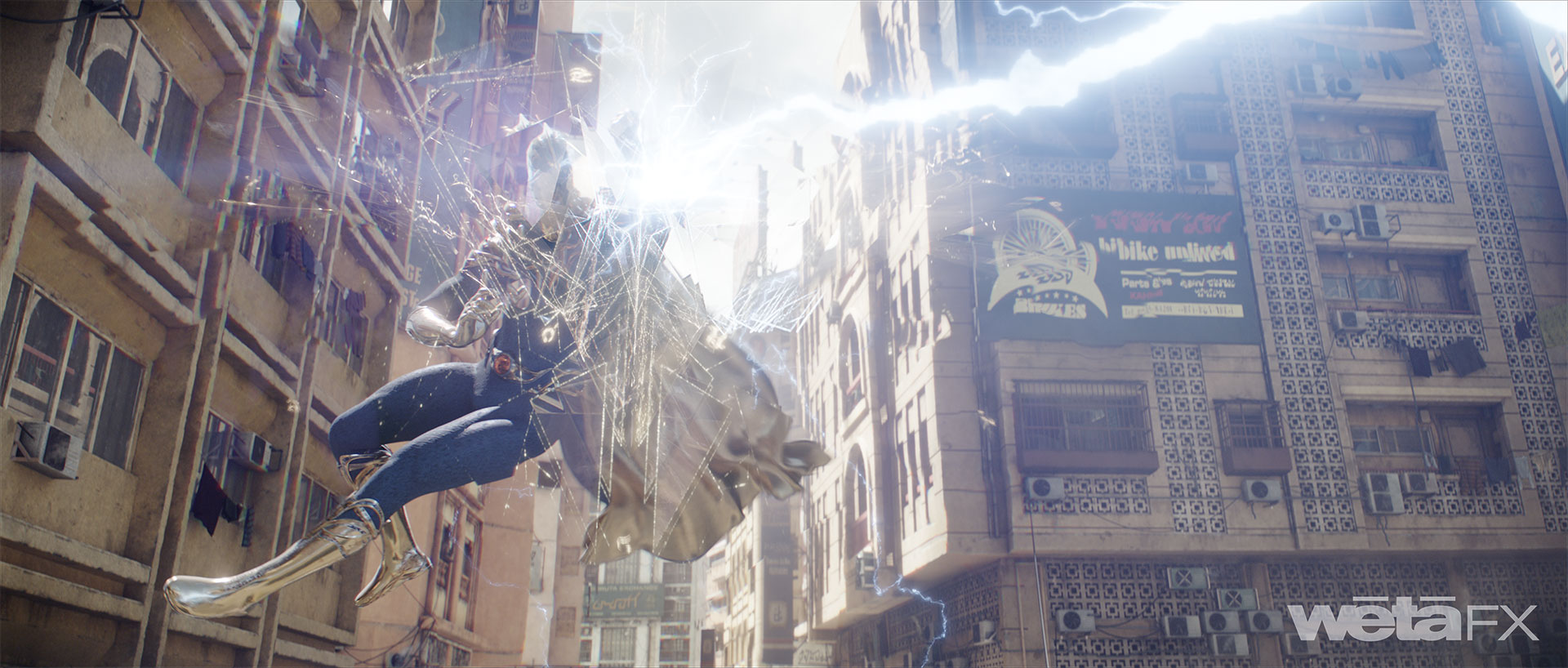
How did you organize the work with your VFX Producer?
Hugo Morris was the Weta FX Producer on the show. We had worked together for a number of years leading up to Black Adam, including on Gemini Man. That meant Hugo was also familiar with Bill and Karen Murphy (Production VFX Producer). At Weta, we started things off as a single team during the early development phase, and as more and more turnover came in we had Charlie Tait join as us second VFX Supervisor. At that point we split the workload across two teams. I was leading “Team Doom” with the main focus on the third act battle. Team Justice, which was led by Charlie, focused on Shiruta and anything leading up to the third act.
What are the sequences made by Weta FX?
Our main body of work was the third act battle. It started with the emergence of Sabbac from the ocean, which quickly led to an intense stand-off with the Justice Society of America (JSA) at the marketplace in Shiruta. As we transitioned over to the palace and throne room, things got even more heated and we ultimately saw Black Adam team up with the JSA to defeat Sabbac. Prior to that, we took care of the JSA’s first meeting with Black Adam in Shiruta, which took place at a location called the “Sunken Street” – a buzzing spot at the heart of Shiruta. We also worked on various Flybike shots as they raced down the streets of Shiruta while Black Adam tries to find Amon, who had been taken by the Ishmael.
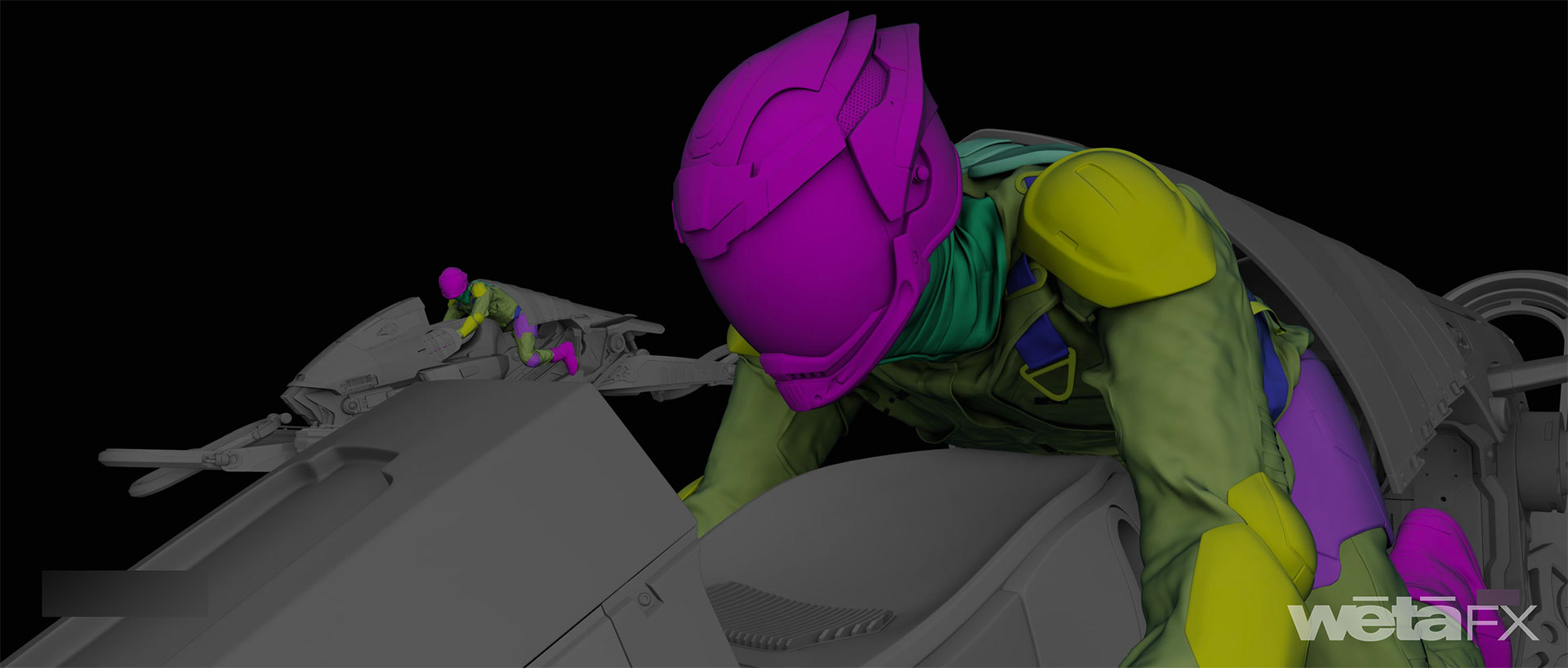
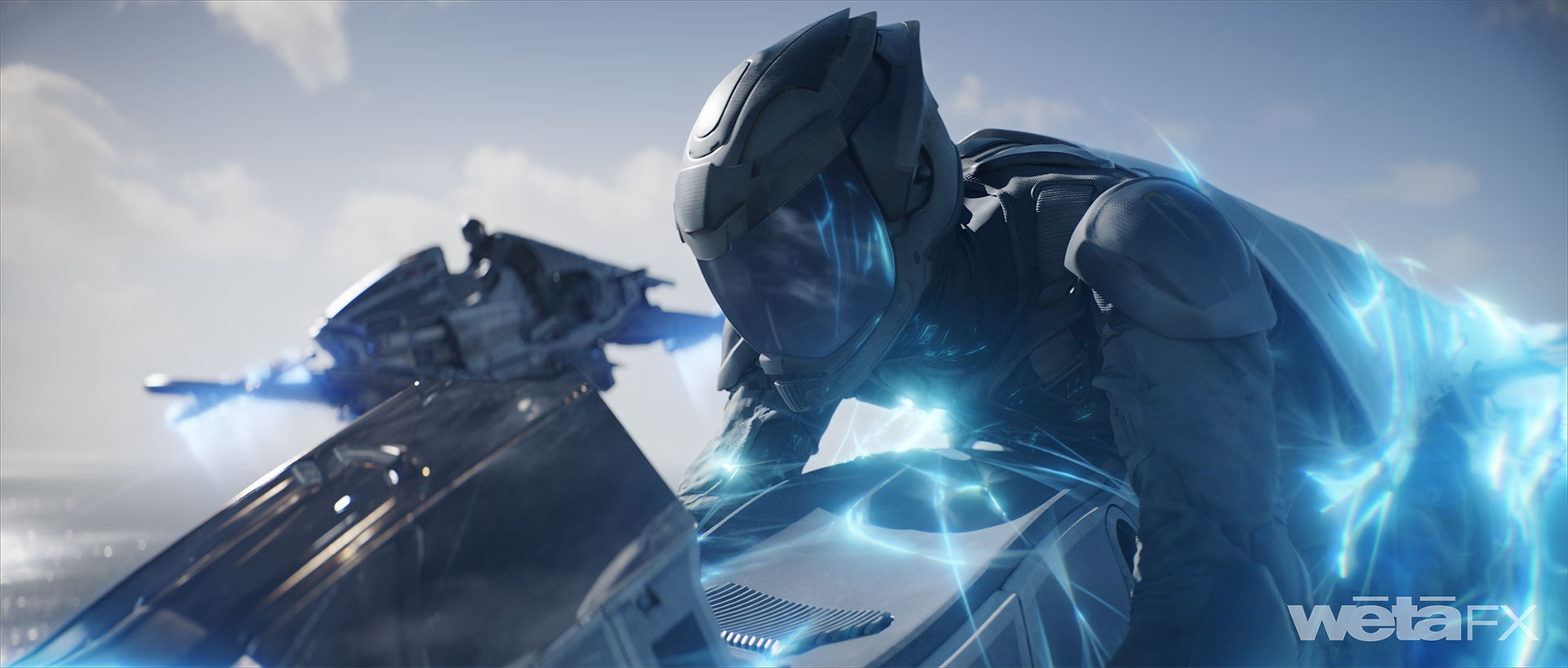
Can you elaborate on the design and creation of the transformation from Teth-Adam to Black Adam?
The transformation from Teth Adam to Black Adam was certainly one of the more demanding shots for us. Ironically, it was one of the earliest to be turned over to us and it was the last one we finished. It was filmed with an extremely high frame rate using a Phantom camera. To make things a little more manageable for the various departments involved, we did a rough temporary version early on to establish the variable camera speed and timing of the suit forming around Dwayne. Once that was done, it allowed us to focus our energy on only the frames we really needed. Our camera lead Jason Locke took care of the challenging camera track and body match-move. Because we needed a one-for-one match to Dwayne’s body shape, our Models Team joined the effort and sculpted our digital character, resulting in a perfect match. Once that was done, our FX lead Injoon Hwang took care of the suit forming effect. The result was a beautiful procedural growth pattern combined with a series of helper outputs that allowed us to control the reveal and light emission in comp. The original idea was to have Black Adam shoot up into the sky and establish a vast view on the surrounding landscape. We shared an early comp version that showed this idea – while it was functional, it was lacking some of the dynamic and sense of speed we were after. Jaume then had the idea to go more extreme and accelerate his upwards trajectory, leading us into this high altitude environment surrounded by clouds. That broke the camels back, as it gave us another backdrop to sell the speed and allowed us to introduce interactive lightning strikes buried within the volumetrics.
How did you create the city?
We knew we would see the city of Shiruta from various angles. We had to cover our bases for high wides, as well moments that we would dive into individual streets. As we established the architecture and look of our building for the Sunken Street location, we explored techniques to utilize the modular buildings blocks we built. We sourced OpenStreetMap data from various middle eastern city and formed our City of Shiruta from that, with custom layouts had to be made to fit the various locations we would feature. The marketplace, Sunken Street, roundabout and palace location all needed to fit into the larger city grid. Once we had our base layout, we filled in the gaps with streets, pavements, lamp posts, cars, street markets and building dressing where needed.
Can you elaborate about the design and creation of the Justice Society?
Each character of the JSA came with its own challenge. While the costume for Hawkman was established practically, we engaged with our Art Department to design his wings and their connection to the practical suit. Dr Fate’s concept work was more or less established as we started, but because there was no full practical suit, we ended up refining various aspects and came up with new ideas. One of them was his belt – when you watch the movie you’ll get glimpse of a dimensional galaxy sitting deep inside it. Cyclone was also an interesting character. While her costume was more or less established practically, it was all about seeing her in the context of a moving shot. Atom Smasher, on the other hand, was all about scale. We needed to adjust our physics-based muscle simulation to the size he was in certain moments in time in order to sell his scale and weight.
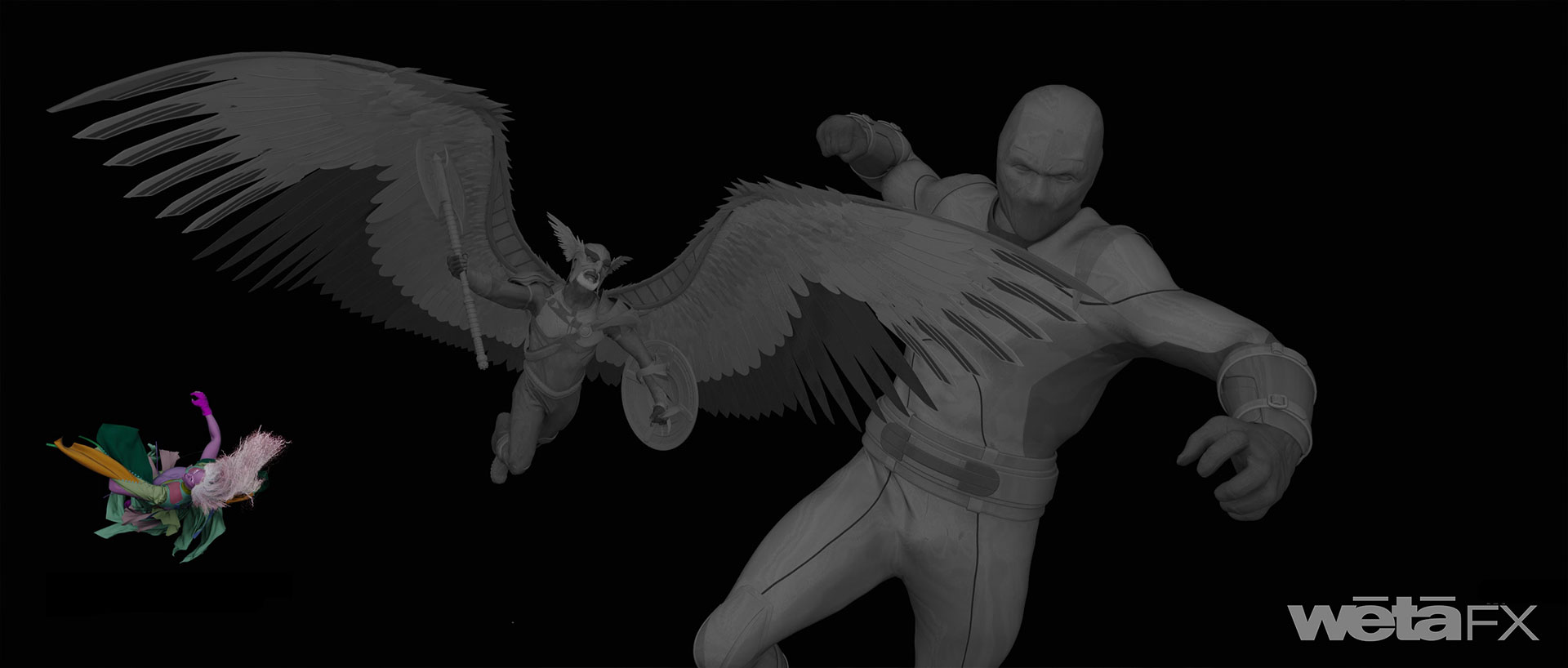
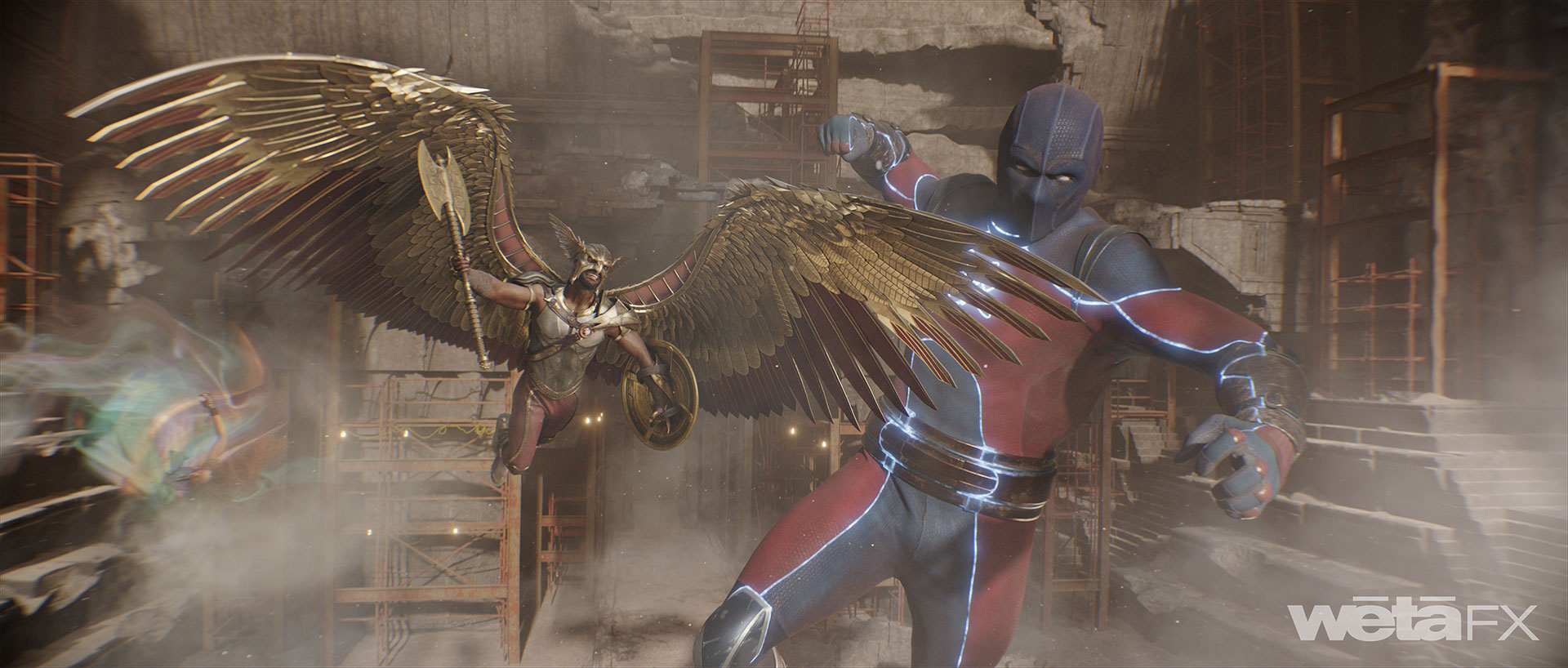
How did you handle the wings for Hawkman?
As mentioned before, we did a few rounds of concept work for his wings. That gave us a visual target to work toward, but it did not answer the question of how we would form and unfold the wings. Alongside the concept work, we also collected a series of motion reference showing the idea of procedural geometry effects. One aspect of his backpack design was a origami like pattern, so we were keen to pick up this idea and have his suit fold out from itself. After various FX explorations, we settled on one pattern everyone liked the best. In shot context, things got a bit more abstract because his wings deploy rather fast, so we combined the FX approach with a more traditional geo formation that was driven by animation.
Can you tell us more about the creation and animation of Cyclone powers?
With Cyclone’s ability to control the wind, we entered a deep dive with FX and compositing as we sought to find a balance with how obscured she is by her powers. Depending on the shot context, we would either see her clearly in her own world in slow motion or bury her in fast, whipping, large scale volumetric simulations. The trick was to find a common language of colourful trails that would work for either scenario. We ended up with a range of techniques that had a common aesthetic. I confess that it took us quite some time to land on something that we felt happy with. Luckily Bill and Jaume we also very positive when we shared the results.
How did you manage the challenges of the clones for Dr. Fate?
Dealing with a multitude of clones quickly becomes a logistical issue, especially for our animation team who needed to work efficiently while dealing with dozens of the same character. We relied on a number of solutions, including firstly blocking out the animation to seek buy off on the number of clones and the broad orchestration of our Dr Fates. By doing this, we were able to avoid spending too much time on background characters before we were happy with the general concept and hero performance. We utilized motion editing to inject initial motion for secondary players. Dr Fate’s cape was the last big piece of the puzzle. Knowing that physics can do unpredictable things, we came up with a system that allowed for guided simulations. Our animation team dictated broad shapes and motion for each cape, which then got picked up our creatures department to run cloth solves against. This gave us much more predictable results and led to a close match between motion and shot final results.
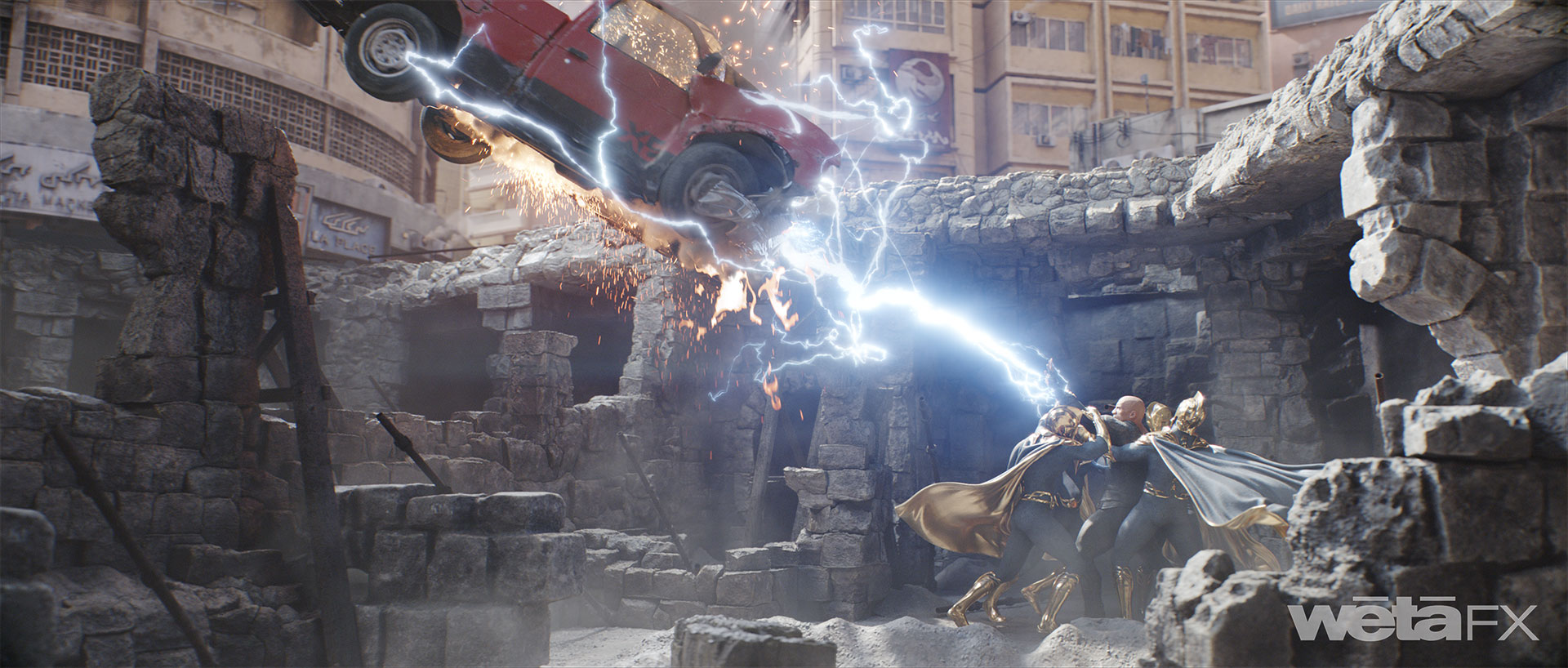
Can you tell us more about the various size changes for Atom Smasher?
For Atom Smasher, we also started with early motion tests. The trick was to figure out what the appropriate scale factor was. We knew that we would be working with motion capture data down the line, but we didn’t know by what factor we would need to slow down this data to arrive at a plausible scale for the varying sizes we would see him in. As we entered production, we came across another set of questions – how would our physically based tissue muscle system deal with the adjusted scale? At a max height of around 80 feet, we were looking at several tons of muscle and fascia running around Shiruta. We wanted to dial in our dynamics to get the right amount of jingle and bounce to sell his scale.
With so many FX elements to render, how did you prevent your render farm from catching fire?
Cloud rendering – it keeps the heat away from your local render farm. But in all seriousness, a big shoutout should go to the entire lighting team. They were the ones managed the multitude of passes that came with this show.
Can you elaborate about the design and creation of the villain Sabbac?
Sabbac was a lot of fun. Before we started, the digital asset production had been through a round of concept work. The final approved concept embodied a 7+ feet tall devil-like creature with a lot of super human features. With his imposing body mass, our models team had to make sure we obeyed physical criteria and created a plausible anatomy. His face received extra attention – since we knew that Sabbac would be played by Marwan Kenzari, we wanted to ensure that his likeness came through in Sabbac’s facial features. There was a general concern that we would lose Marwan when transforming him into a 7 feet tall devil with horns, however we managed to put this fear quickly to bed when we shared our initial facial motion applied to Sabbac. The shading of Sabbac was an ongoing journey, and we certainly didn’t rush this process, as we wanted to allow our team to work up every detail extensively. Knowing that Sabbac would be seen on screen from head to toe, we wanted to ensure that he would hold up in any situation we might find him. We leveraged existing toolsets developed over the recent years, but we also encountered some new challenges. As part of his story, we needed to introduce an internal fire to him. His crown and chest pentagram were energised by adding emissive blackbody components, which could played up or down depending on his action on screen.
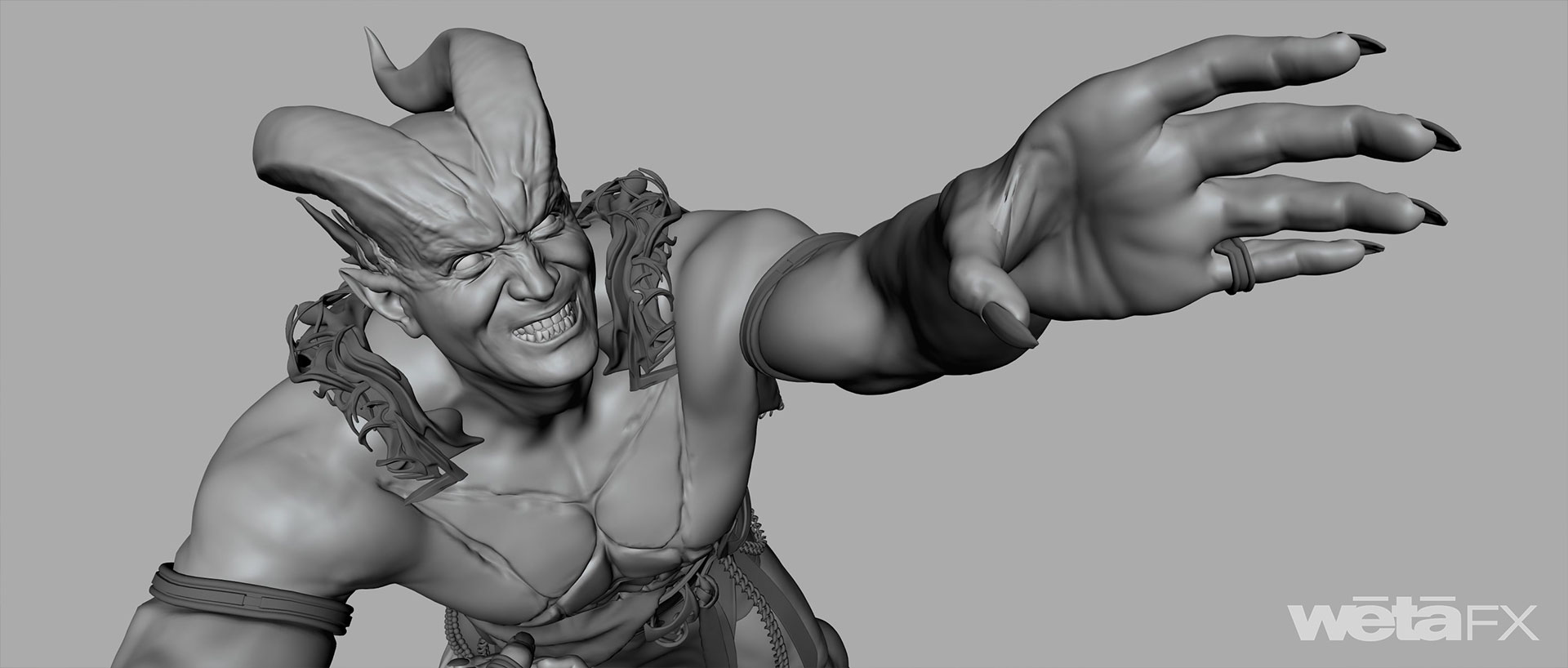
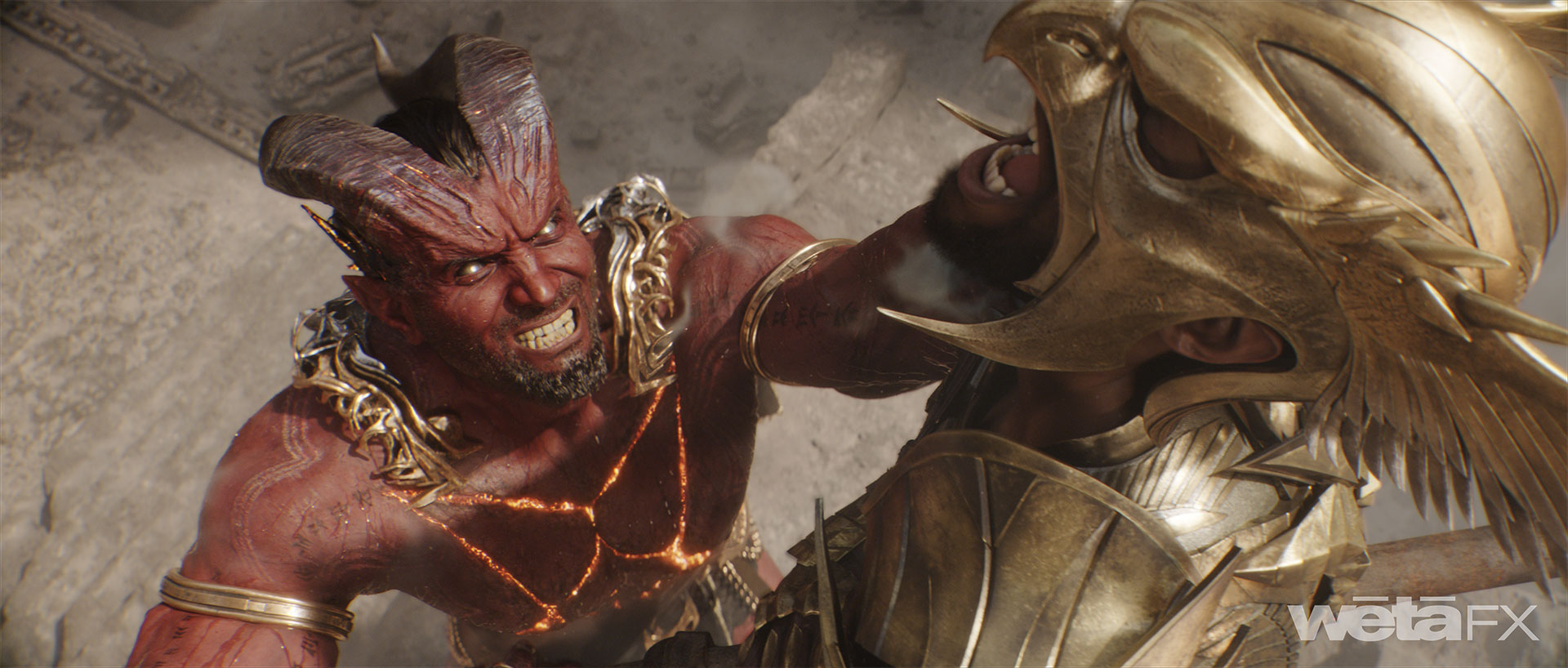
What kind of references and influences did you receive for him?
Concept work laid the foundation for our efforts. From there it was a combination of Cyberscan and photo reference of Marwan Kenzari. His eyes got special attention, as the concept implied his eyes were lit up. We tried early tests where we made his eyes emissive, but concluded that it looked too artificial. Instead we opted for an idea we explored on other shows in the past, where we played with a retroreflective membrane within the eye. This would allow for the eyes to have a natural shimmer in dark environments without forcing them to emit light.
How did you choreograph his intense fight against the Justice Society of America and then Black Adam?
I want to give credit to our animation teams for that. Paul Story and Paul Ramsden were the two Animation Supervisors on the show, and both did an incredible job working with the entire Motion team to come up with a solution that allowed for the scale of this fight
What was the main challenge with this epic fight?
Keeping track of all the moving pieces became the main challenge. We really relied on all departments to pull on the same string, ensuring clean hand offs. A good example of that were the spells that Dr Fate used to attack Sabbac. We thought of them much like tracer fire, even though they obviously didn’t look anything like. We used a similar technique, where we tracked each of the spells with animation while defining their state. Attributes such as the birth, launch, or hit of a spell were passed down into the pipeline and made available to the various disciplines that needed to have access to them. The spells themselves were generated in compositing space – our Compositing Lead Alex Berson deserves a special shout out as he did some serious heavy lifting with all magic related matters.
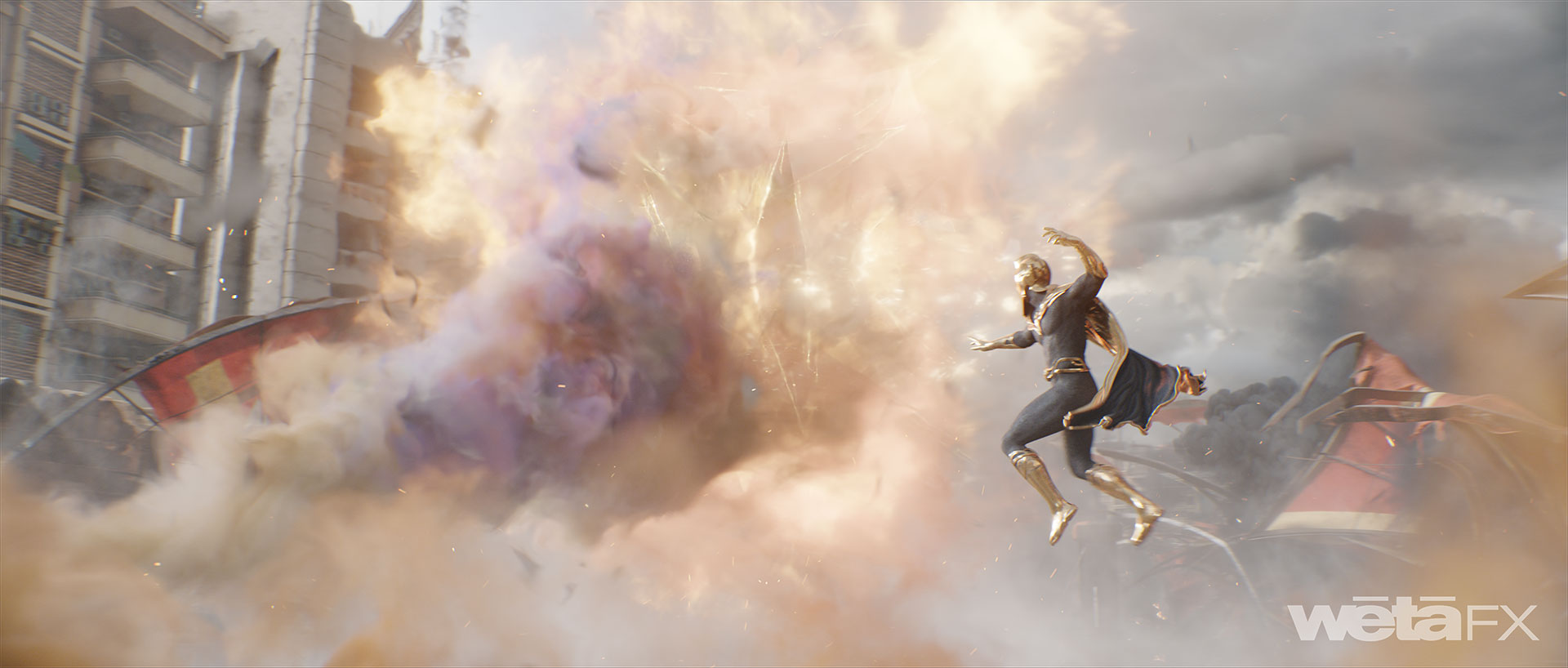
Which shot or sequence was the most challenging?
It’s almost impossible to single out a shot or sequence, but I can say that commonly the bits you think are going to be easy turn out to be the hardest – and vice versa. Variable speed and retimes are worth mentioning here. The fun fact about this type of effect is that it typically sits on top of the work you are already up against. You can think of it as a multiplier that increases the level complexity you are dealing with. Knowing there isn’t just one solution to deal with speed changes, we started talking about the challenge early on and to be honest, we didn’t stop talking about until the show was done. There was always a new solution to discover and consider.
Is there something specific that gave you some really short nights?
I slept pretty well during the making of Black Adam, mostly because of the quality of the team we had. Things that made me daydream were typically related to aesthetics. Each of our sequences demanded a certain look, so finding the right one was challenging at times, but once we settled on something that Jaume and Bill liked, it was relatively smooth sailing from there.
What is your favourite shot or sequence?
I have two daughters at home and have learned not to pick favourites. What I am proud of on Black Adam is the consistency the team managed to deliver. Across the board the quality was high and I believe we managed to maintain this until the end.
What is your best memory on this show?
Getting first-hand approval from Pierce Brosnan for his CG suit. Certainly a highlight in my career.
How long have you worked on this show?
From start to finish, more or less 2 years. Time flies when you are having fun.
What’s the VFX shots count?
We delivered around 600 shots for the final movie.
What was the size of your team?
I am not sure I can disclose the exact size of the team with you, but we did the math and calculated that it would have taken me 116 years to do Black Adam all by myself. Needless to say that I wouldn’t have been able to do such a good job.
What is your next project?
Afraid it is a little too early to disclose what the future holds for me, but watch this space.
A big thanks for your time.
WANT TO KNOW MORE?
Weta FX: Dedicated page about Black Adam on Weta FX website.
© Vincent Frei – The Art of VFX – 2022






